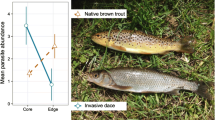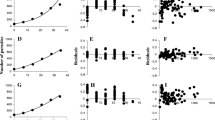Abstract
Disease-mediated impacts of exotic species on their native counterparts are often ignored when parasite-free individuals are translocated. However, native parasites are frequently acquired by exotic species, thus providing a mechanism through which native host-parasite dynamics may be altered. In Argentina, multiple exotic salmonids are host to the native fish acanthocephalan parasite Acanthocephalus tumescens. Field evidence suggests that rainbow trout, Oncorhynchus mykiss, may be a major contributor to the native parasite’s population. We used a combination of experimental infections (cystacanth—juvenile worm transmission from amphipod to fish; post-cyclic—adult worm transmission between definitive fish hosts) and dynamic population modelling to determine the extent to which exotic salmonid hosts may alter A. tumescens infections in native freshwater fish. Experimental cystacanth infections demonstrated that although A. tumescens establishes equally well in native and exotic hosts, parasite growth and maturity is superior in exotic O. mykiss. Experimental post-cyclic infections also showed greater establishment success of A. tumescens in O. mykiss, though post-cyclic transmission did not result in greater parasite size or maturity. Dynamic population modelling, however, suggested that exotic salmonids may have a very limited influence on the A. tumescens population overall, due to the majority of A. tumescens individuals being maintained by more abundant native hosts. This research highlights the importance of considering both a host’s relative density and its competency for parasites when evaluating whether exotic species can modify native host-parasite dynamics.


Similar content being viewed by others
References
Arismendi I, Soto D, Penaluna B, Jara C, Leal C, Leon-Munoz J (2009) Aquaculture, non-native salmonid invasions and associated declines of native fishes in Northern Patagonian lakes. Freshw Biol 54(5):1135–1147. doi:10.1111/j.1365-2427.2008.02157.x
Bello MT (1995) Ecologia de la ictiofauna de un sector del Lago Moreno. Universidad Nacional del Comahue, Proyecto de Investigacion, San Carlos de Bariloche
Brown AF (1986) Evidence for density-dependent establishment and survival of Pomphorhynchus laevis (Muller, 1776) (Acanthocephala) in laboratory-infected Salmo gairdneri Richardson and its bearing on wild populations in Leuciscus cephalus (L). J Fish Biol 28(6):659–669. doi:10.1111/j.1095-8649.1986.tb05201.x
Cherwell (2000) Modelmaker user manual. Cherwell Scientific Limited, Oxford
Clements J (1988) Salmon at the antipodes: a history and review of trout, salmon and char and introduced coarse fish in Australasia. Skipton, Ballarat
Crompton DW (1970) An ecological approach to acanthocephalan physiology. Cambridge University Press, Cambridge
Crompton DW, Whitfield PJ (1968) Course of infection and egg production of Polymorphus minutus (Acanthocephala) in domestic ducks. Parasitol 58:231–246. doi:10.1017/S0031182000073583
Daszak P, Cunningham AA, Hyatt AN (2000) Emerging infectious diseases of wildlife: threats to biodiversity and human health. Science 287:443–449. doi:10.1126/science.287.5452.443
Dobson AP (1988) The population biology of parasite-induced chances in host behavior. Q Rev Biol 63:139–165
Hershberger P, Gregg J, Grady C, Collins R, Winton J (2010a) Kinetics of viral shedding provide insights into the epidemiology of viral hemorrhagic septicemia in Pacific herring. Mar Ecol Prog Ser 400:187–193. doi:10.3354/meps08420
Hershberger P, van der Leeuw B, Gregg J et al (2010b) Amplification and transport of an endemic fish disease by an introduced species. Biol Invasions 12:3665–3675. doi:10.1007/s10530-010-9760-5
Holey ME, Elliott RF, Marcquenski SV, Hnath JG, Smith KD (1998) Chinook salmon epizootics in Lake Michigan: possible contributing factors and management implications. J Aquat Anim Health 10(2):202–210. doi:10.1577/1548-8667(1998)010<0202:Cseilm>2.0.Co;2
Jenkins M (2003) Prospects for biodiversity. Science 302(5648):1175–1177. doi:10.1126/science.1088666
Kelly DW, Paterson RA, Townsend CR, Poulin R, Tompkins DM (2009a) Has the introduction of brown trout altered disease patterns in native New Zealand fish? Freshw Biol 54(9):1805–1818. doi:10.1111/j.1365-2427.2009.02228.x
Kelly DW, Paterson RA, Townsend CR, Poulin R, Tompkins DM (2009b) Parasite spillback: a neglected concept in invasion ecology? Ecology 90(8):2047–2056. doi:10.1890/08-1085.1
Kennedy CR (1999) Post-cyclic transmission in Pomphorhynchus laevis (Acanthocephala). Folia Parasitol 46(2):111–116
Kennedy CR, Bush AO (1994) The relationship between pattern and scale in parasite communities: a stranger in a strange land. Parasitology 109(02):187–196. doi:10.1017/S0031182000076290
Kolar CS, Lodge DM (2001) Progress in invasion biology: predicting invaders. Trends Ecol Evol 16(4):199–204. doi:10.1016/S0169-5347(01)02101-2
Krkosek M, Lewis MA, Volpe JP (2005) Transmission dynamics of parasitic sea lice from farm to wild salmon. Proc R Soc London Ser B 272:689–696. doi:10.1098/rspb.2004.3027
Macchi PJ, Cussac VE, Alonso MF, Denegri MA (1999) Predation relationships between introduced salmonids and the native fish fauna in lakes and reservoirs in northern Patagonia. Ecol Freshw Fish 8(4):227–236. doi:10.1111/j.1600-0633.1999.tb00074.x
Macchi PJ, Pascual MA, Vigliano PH (2007) Differential piscivory of the native Percichthys trucha and exotic salmonids upon the native forage fish Galaxias maculatus in Patagonian Andean lakes. Limnologica 37(1):76–87. doi:10.1016/j.limno.2006.09.004
Mastitsky SE, Veres JK (2010) Field evidence for a parasite spillback caused by exotic mollusc Dreissena polymorpha in an invaded lake. Parasitol Res 106(3):667–675. doi:10.1007/s00436-010-1730-4
Milano D (1996) Reproducción de la perca de boca chica Percichthys trucha (Cuvier & Valenciennes, 1840) del lago Moreno. Dissertation, Universidad Nacional del Comahue
Milano ME (2003) Biología de Galaxias platei (Pisces, Galaxiidae): especializaciones relativas a su distribución. Dissertation, Universidad Nacional del Comahue
Miller DJ (1989) Introductions and extinction of fish in the African great lakes. Trends Ecol Evol 4(2):56–59. doi:10.1016/0169-5347(89)90145-6
Nichol ST, Rowe JE, Winton JR (1995) Molecular epizootiology and evolution of the glycoprotein and non-virion protein genes of infectious hematopoietic necrosis virus, a fish rhabdovirus. Virus Res 38:159–173. doi:10.1016/0168-1702(95)00054-T
Nickol BB (1985) Epizootiology. In: Crompton DWT, Nickol BB (eds) Biology of the Acanthocephala. Cambridge University Press, Cambridge, pp 307–346
Pascual MA, Lancelotti JL, Ernst B, Ciancio JE, Aedo E, Garcia-Asorey M (2009) Scale, connectivity, and incentives in the introduction and management of non-native species: the case of exotic salmonids in Patagonia. Front Ecol Environ 7(10):533–540. doi:10.1890/070127
Paterson RA, Townsend CR, Poulin R, Tompkins DM (2011) Introduced brown trout alter native acanthocephalan infections in native fish. J Anim Ecol 80(5):990–998. doi:10.1111/j.1365-2656.2011.01834.x
Paterson RA, Townsend CR, Tompkins DM, Poulin R (2012) Ecological determinants of parasite acquisition by exotic fish species. Oikos 121(11):1889–1895. doi:10.1111/j.1600-0706.2012.20143.x
Poulin R, Mouillot D (2003) Host introductions and the geography of parasite taxonomic diversity. J Biogeogr 30(6):837–845. doi:10.1046/j.1365-2699.2003.00868.x
Rauque CA, Semenas L (2007) Infection pattern of two sympatric acanthocephalan species in the amphipod Hyalella patagonica (Amphipoda: Hyalellidae) from Lake Mascardi (Patagonia, Argentina). Parasitol Res 100(6):1271–1276. doi:10.1007/s00436-006-0420-8
Rauque CA, Semenas LG, Viozzi GP (2002) Post-cyclic transmission in Acanthocephalus tumescens (Acanthocephala: Echinorhynchidae). Folia Parasitol (Ceske Budejovice) 49(2):127–130
Rauque CA, Viozzi GP, Semenas LG (2003) Component population study of Acanthocephalus tumescens (Acanthocephala) in fishes from Lake Moreno, Argentina. Folia Parasitol 50(1):72–78
Rauque CA, Semenas LG, Viozzi GP (2006) Seasonality of recruitment and reproduction of Acanthocephalus tumescens (Acanthocephala) in fishes from Lake Moreno (Patagonia, Argentina). J Parasitol 92(6):1265–1269. doi:10.1645/GE-764R1.1
Revenga JE, Torres PF, Baiz M (2005) Impact of a caged—trout farm on parasites of Galaxias maculatus in Lake Moreno, Southern Argentina. J Parasitol 91(3):707–709. doi:10.1645/GE-441R
Sala OE, Chapin FS, Armesto JJ et al (2000) Biodiversity–global biodiversity scenarios for the year 2100. Science 287(5459):1770–1774. doi:10.1126/science.287.5459.1770
Sato M, Kawaguchi Y, Nakajima J, Mukai T, Shimatani Y, Onikura N (2010) A review of the research on introduced freshwater fishes: new perspectives, the need for research, and management implications. Landsc Ecol Eng 6(1):99–108. doi:10.1007/s11355-009-0086-3
Semenas L, Trejo A (1997) Redescription of Acanthocephalus tumescens (von Linstow, 1896) (Palaeacanthocephala: Echinorhynchidae) in Galaxias maculatus (Pisces: Galaxiidae) in Patagonia (Argentina). Syst Parasitol 36(1):13–16. doi:10.1023/A:1005725919148
SPSS (2006) SPSS for Windows Version 15.0.0. SPSS, Inc., Chicago
Tekinay AA, Guner Y, Davies SJ (2003) Influence of dietary energy level on stomach emptying and appetite revival rates in rainbow trout, Oncorhynchus mykiss. Turk J Vet Anim Sci 27(5):1077–1084
Tompkins DM, Poulin R (2006) Parasites and biological invasions. In: Allen RB, Lee WG (eds) Biological invasions in New Zealand. Springer, Berlin, pp 67–86
Tompkins DM, White AR, Boots M (2003) Ecological replacement of native red squirrels by invasive greys driven by disease. Ecol Lett 6(3):189–196. doi:10.1046/j.1461-0248.2003.00417.x
Townsend CR (2003) Individual, population, community, and ecosystem consequences of a fish invader in New Zealand streams. Conserv Biol 17(1):38–47. doi:10.1046/j.1523-1739.2003.02017.x
Valiente AG, Juanes F, Nunez P, Garcia-Vazquez E (2010) Brown trout (Salmo trutta) invasiveness: plasticity in life-history is more important than genetic variability. Biol Invasions 12(3):451–462. doi:10.1007/s10530-009-9450-3
Vigliano PH, Beauchchamp DA, Milano D et al (2009) Quantifying predation on galaxiids and other native organisms by introduced rainbow trout in an ultraoligotrophic lake in northern Patagonia, Argentina: a bioenergetics modeling approach. Trans Am Fish Soc 138:1405–1419. doi:10.1577/T08-067.1
Wiles GJ, Bart J, Beck RE, Aguon CF (2003) Impacts of the brown tree snake: patterns of decline and species persistence in Guam’s avifauna. Conserv Biol 17(5):1350–1360. doi:10.1046/j.1523-1739.2003.01526.x
Winemiller KO, Rose KA (1992) Patterns of life history diversification in North American fishes: implications for population regulation. Can J Fish Aquat Sci 49(10):2196–2218. doi:10.1139/f92-242
Acknowledgments
We wish to thank L. Semenas, G. Viozzi, R. Vega (Laboratorio de Parasitología, Universidad Nacional del Comahue), M. Alonso, P. Di Giusto, O. Quatrin, M. Ugoccioni, V. Baez and the staff of Centro de Salmonicultura Bariloche for their assistance. Funding for this project was provided by a Marsden grant (Royal Society of New Zealand), Landcare Research, and the Elman Poole Travelling Fellowship (RAP). The manuscript was greatly improved by the comments of three anonymous reviewers.
Author information
Authors and Affiliations
Corresponding author
Rights and permissions
About this article
Cite this article
Paterson, R.A., Rauque, C.A., Fernandez, M.V. et al. Native fish avoid parasite spillback from multiple exotic hosts: consequences of host density and parasite competency. Biol Invasions 15, 2205–2218 (2013). https://doi.org/10.1007/s10530-013-0445-8
Received:
Accepted:
Published:
Issue Date:
DOI: https://doi.org/10.1007/s10530-013-0445-8




